Despite only making it to the semi-finals of an international competition once, with that journey occurring back in 1997, Spain enter this competition as one of the favourites. Led by 40-year-old Jorge Vilda, Spain aim to translate their recent growth and domestic success, especially Barcelona’s, to their national team. This Spanish generation is responsible for taking La Roja to the next step. After making it to the quarter-finals in the 2013 Women’s Euro, they qualified for the 2015 World Cup for the first time in their history. Similar success was maintained in the next cycle, but they took it further by qualifying for the Round of 16 in the 2019 World Cup. With a mixture of experienced first-class players and a few talented youngsters, they look to take the final step and enter the world’s elite in this World Cup cycle.
The Women’s Euro 2022 provides the perfect opportunity for La Roja. Jorge Vilda has been in charge since 2015, having previously been managing Spain’s national youth teams. After almost seven years in charge, Vilda’s identity is imprinted onto this talented Spain side. Spain’s Group B is a rather tricky one, with no easy matches on the horizon. While Finland may be their weakest opponent, they still have some very good players in Portland Thorns defender Natalia Kuikka and former Montpellier forward Adelina Engman. Furthermore, Germany and Denmark have very dangerous sides, and these two matches will prove incredibly decisive. With only three matches in the group stage, the margin for error will be extremely small. This tactical analysis aims to describe the tactics used by Spain throughout the four phases. In addition, this analysis will also look at key players, probable lineups, and more.
Predicted Starting XI
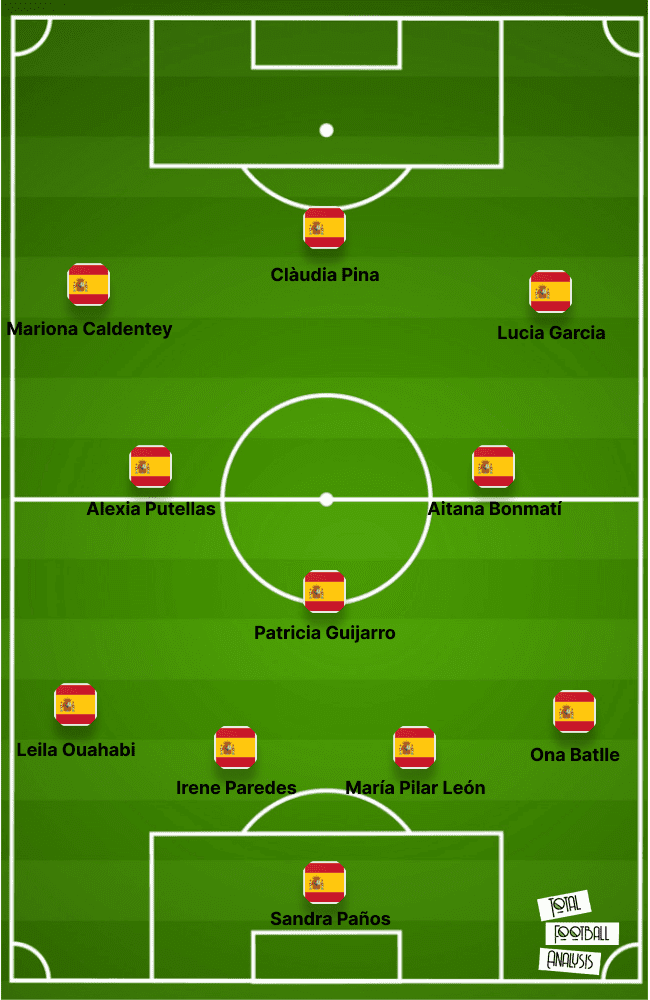
Jorge Vilda’s Spain are structured in a traditional 4-3-3. This formation perfectly complements Vilda’s tactics and the Spanish identity. As we will see in this analysis, La Roja’s playing style is built around the idea of having the ball and Vilda is able to execute this style so effectively due to the overwhelming talent in his hands.
From the starting XI seen above, nine of them play for Barcelona, who happen to be one of the most dominant teams in the world at present. Not only are they incredibly talented, but they are also very familiar with playing alongside each other. Familiarity tends to be a significant factor in national teams, especially ones filled with such talent. It is fair to say Spain won’t suffer from this. In addition to having a large core from Barcelona, they also possess some of the best talents from the remaining teams. La Roja have incredible depth and tremendous quality.
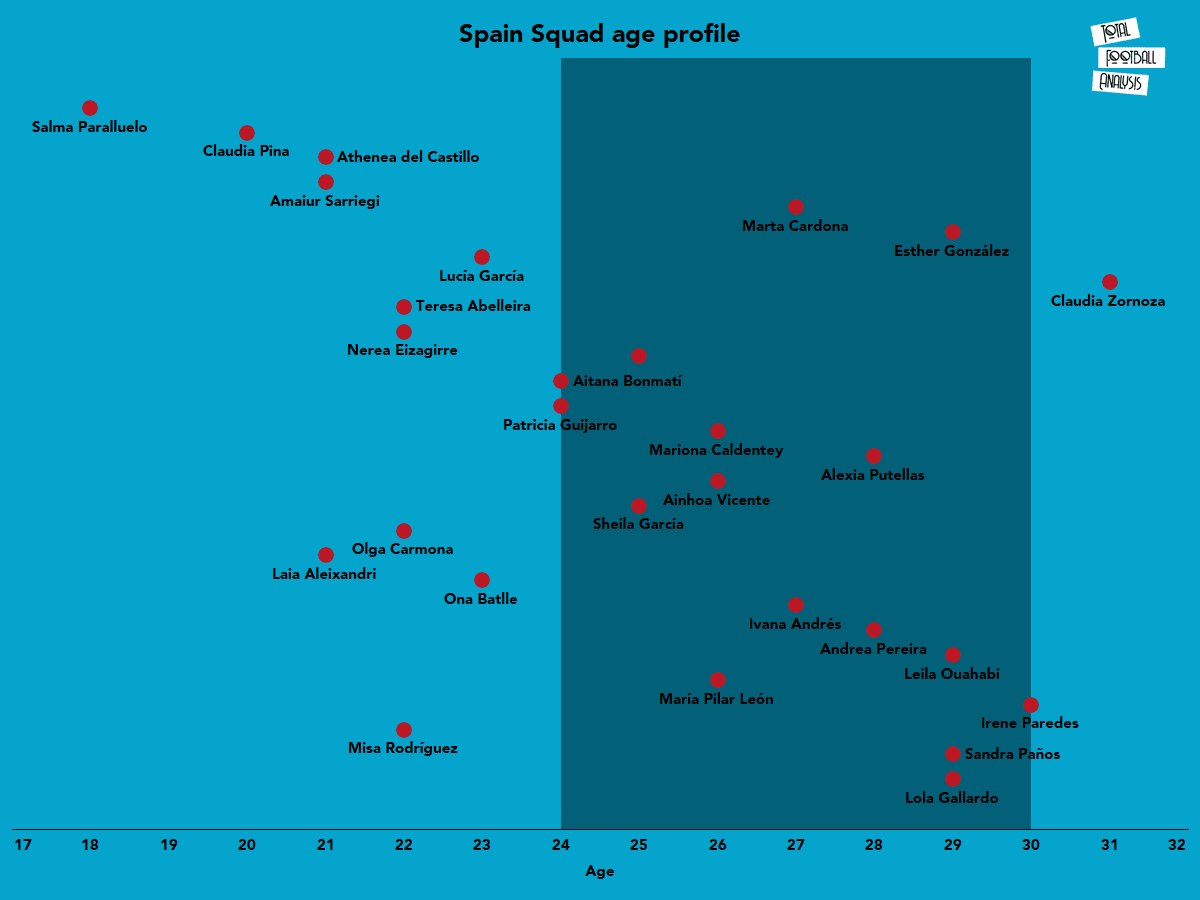
As far as the age profile, we can see that the majority of this Spanish squad are in their prime. With the exception of Claudia Zornoza, there are no players over 30. On the other hand, there are a few very good young players breaking into the team. While still somewhat young, Jorge Vilda could not have asked for a better age profile to work with.
Attacking Phase
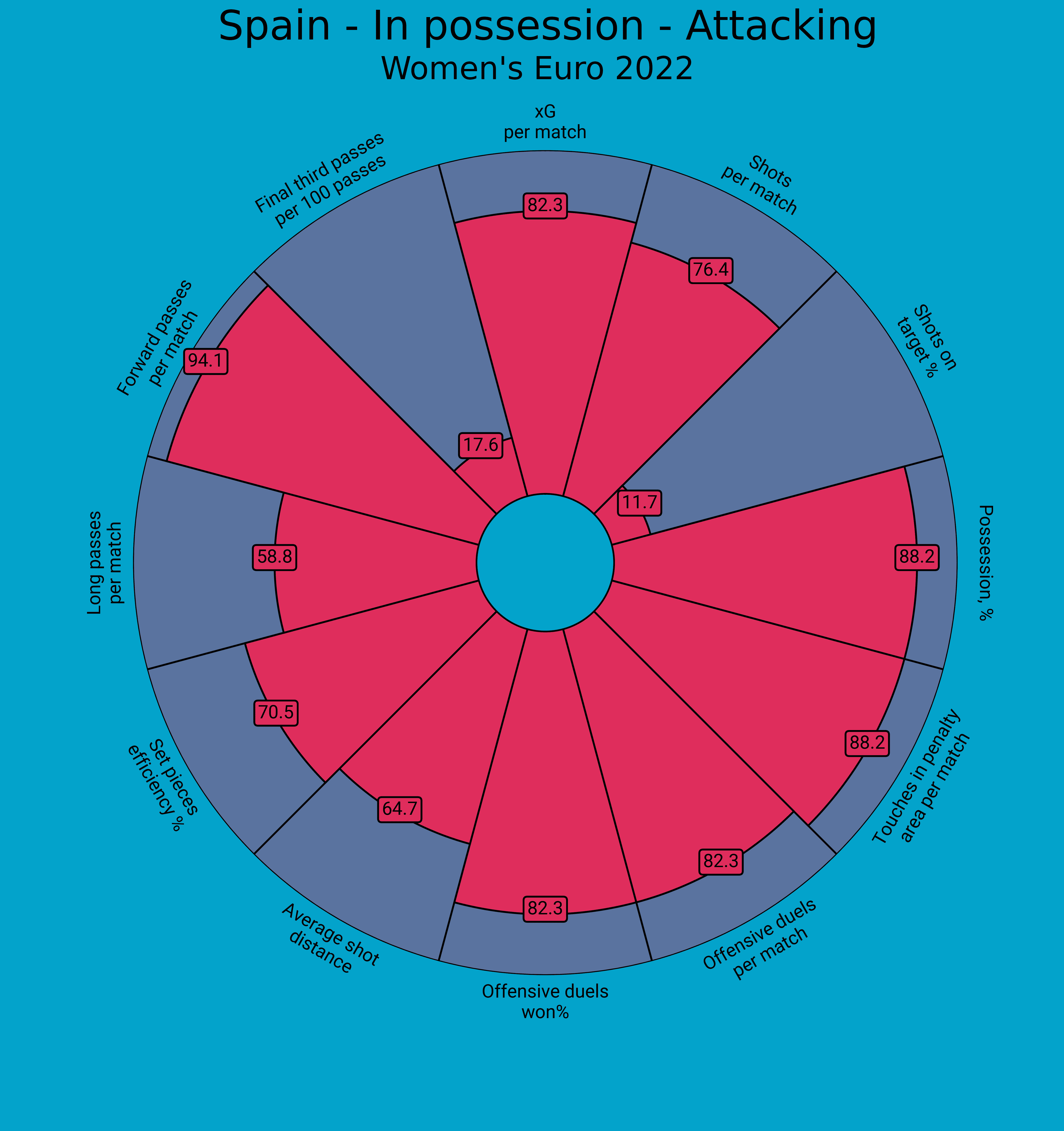
In 2010, the men’s first World Cup title symbolised decades of evolution, evolution not only in quality but in identity. The contribution of foreign legends such as Alfredo Di Stéfano and Johan Cruyff in shaping this identity cannot be understated. Nonetheless, Spain had their own philosophy and playing style. This identity has not only been preserved throughout recent generations, but it has also translated into the women’s national team.
Some may not like Jorge Vilda, but his alignment with the traditional Spanish style cannot be disputed. These tactics can be seen on many levels. The statistics mirror what any tactical analysis would display, from organisation to behaviour. Some credit must also be given to the fact that a majority of the squad play for Barcelona, a team with a strong and very similar identity.
In the attacking phase, Spain is famous for its high tempo controlled possession style. This style is built around the desire for the ball, not necessarily space. Dominating possession and averaging an incredibly high number of passes is almost a requirement, as it exclusively allows them to carry out their principles. Relentless pressing is, of course, a huge factor in that as we will examine later. However, there are a few key principles that are not only important but define their style.
First, it is important to understand their structure. Vilda prefers a traditional 4-3-3 shape, and this is maintained in possession. This structure is very fluid and free-flowing for two reasons. Firstly, players have varying roles which will see them occupying different spaces throughout the pitch. Additionally, their system is based on constant approximation and numerical superiority. As a consequence, players will freely flow among themselves and not have such a rigid structure. Initially, though, the structure will be a 4-3-3.
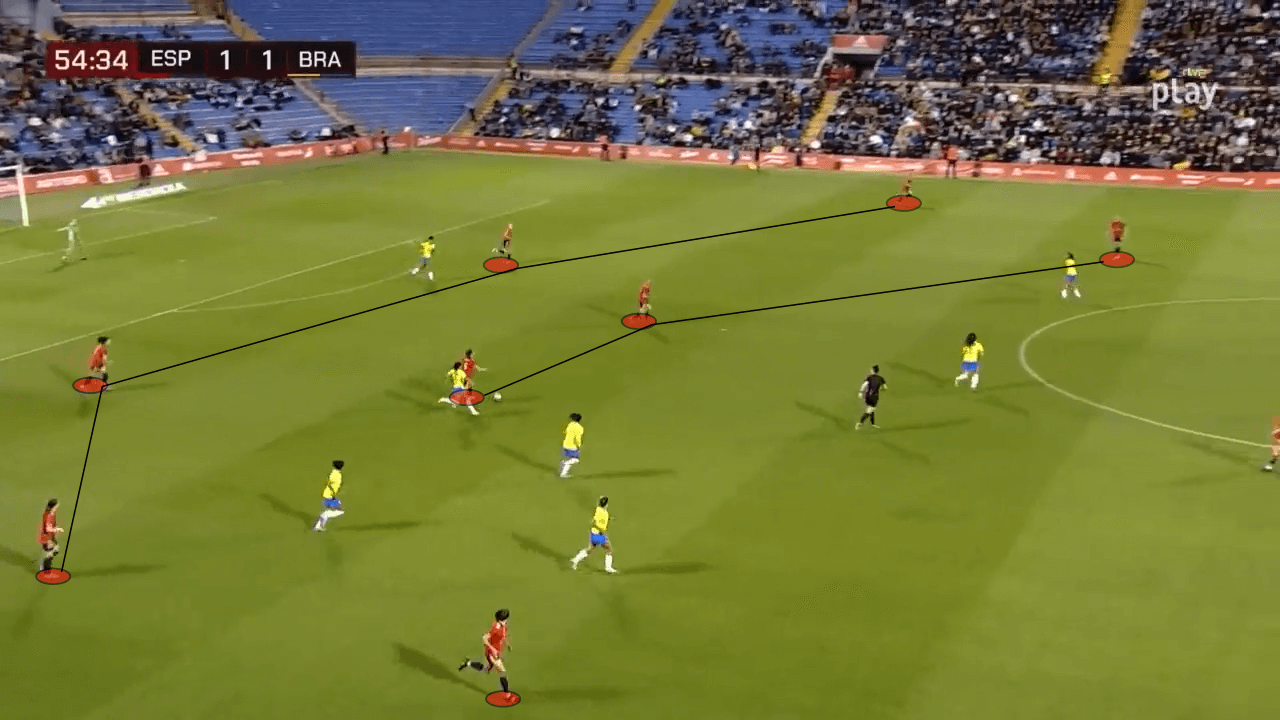
One of the main principles that allow for this style of controlled possession is constant approximation. La Roja are famous for relentless quick short passes. They essentially aim to create numerical superiority around the ball to progress through the zones as a unit and in a controlled fashion. In order for this to work, players must constantly support possession. Simply standing around the ball, though, would congest play and be far too easy to defend. On the contrary, players are in constant movement to find space to receive the ball, disrupt the defensive organisation, and support possession. Following a loose 4-3-3 structure, players will flow naturally to retain possession.
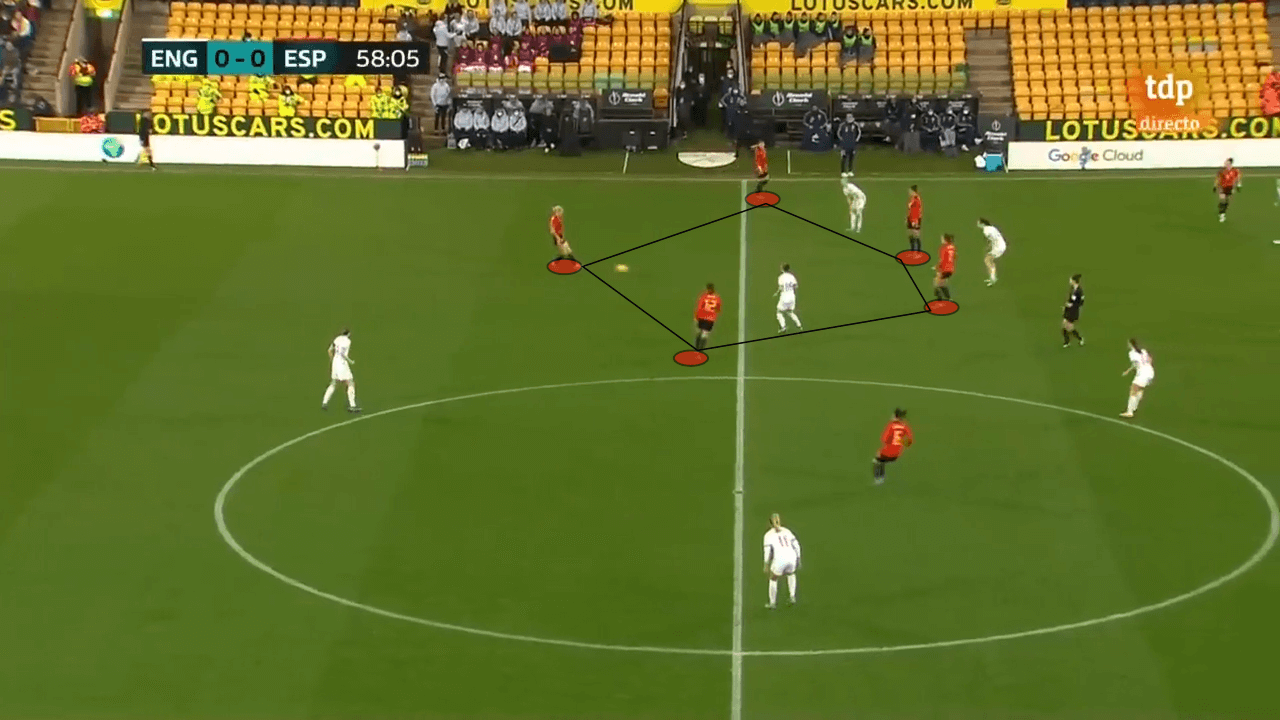
Constant movement is a crucial factor in allowing this system to be effective. It significantly disrupts the defensive structure and creates space. In the example below, Hermoso makes a quick pass to Ouahabi, who instantly passes it wide for Putellas. Meanwhile, Hermoso is already attacking the depth. By doing this, she creates space where she previously was while also offering another passing lane.
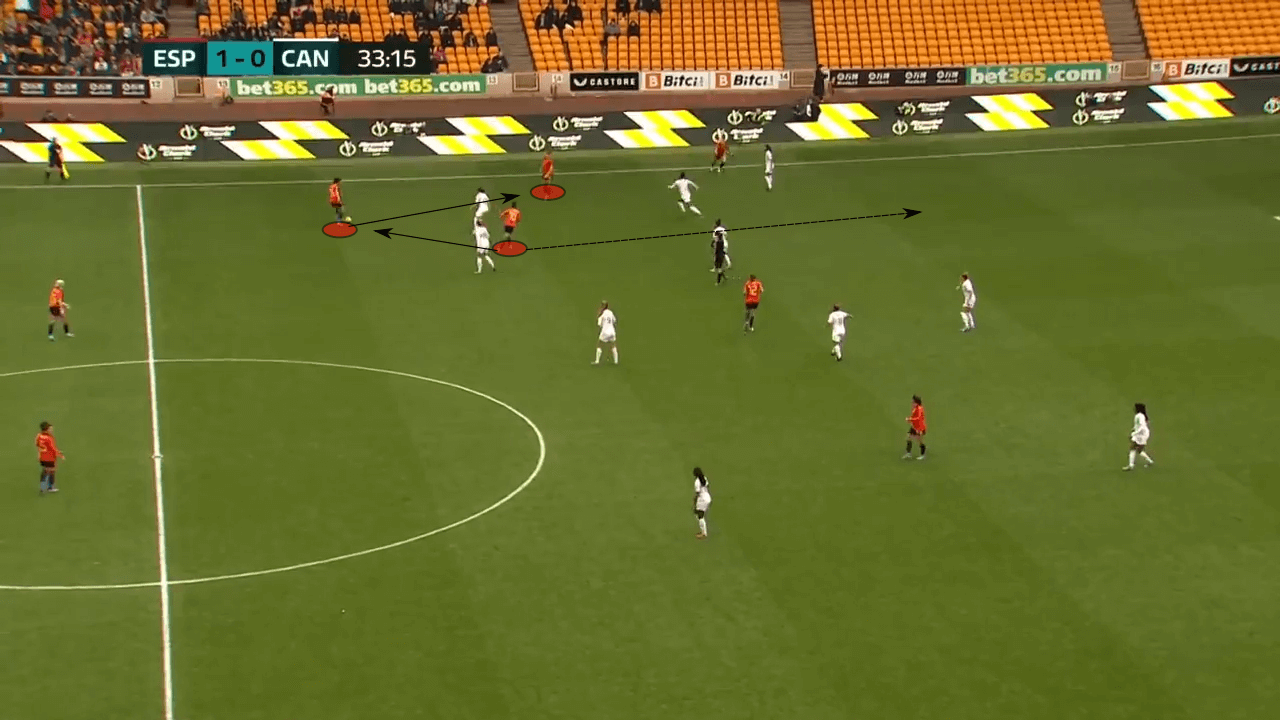
In summary, Vilda’s Spain has the famous Spanish style of possession-based, high-tempo short pass-heavy football. Numerous principles are essential for this style to be effective, and La Roja execute them very well. This ideal style is not only executed well but clearly translates into statistics. As seen in the initial statistical overview, Spain often dominate possession in the opposition half. A high number of shots per match and touches in the opposition penalty area further illustrate this.
Defensive Phase
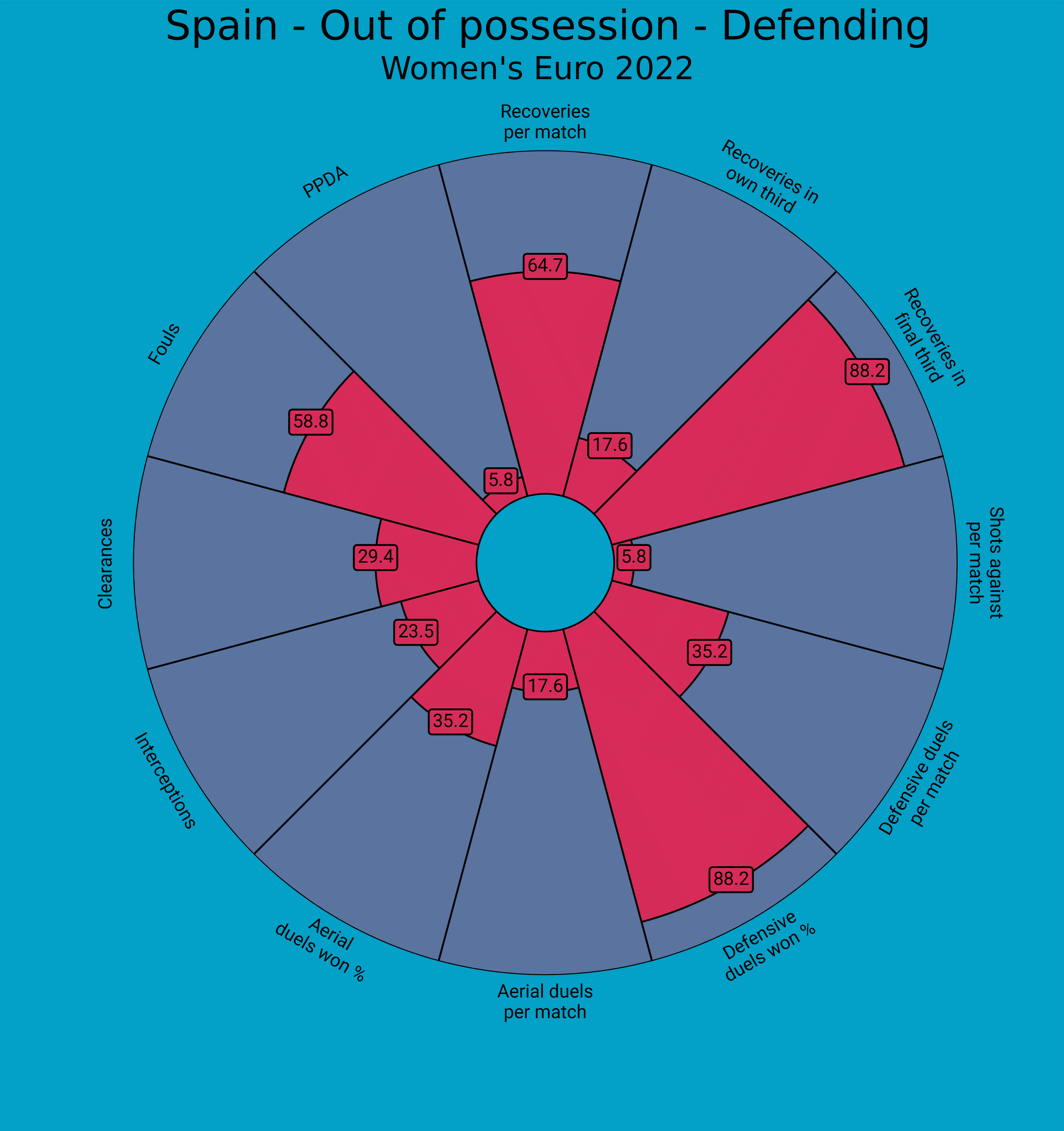
As mentioned, Spain’s idea of football is built around having the ball. Therefore, when not in possession, the objective is to recover it as soon as possible. This is clearly translated into their statistics. As seen above, they rank significantly low in the volume of aerial duels, interceptions, clearances, and shots against. This is a consequence of often dominating possession and simply not having to defend as much. This domination, though, is not simply given, but rather earned through their relentless work in the defensive phase.
La Roja rank significantly high in recoveries in the final third and the percentage of defensive duels won. These metrics highlight where they do their defensive work and how effective they are. Their PPDA rank is incredibly low as they average a very low PPDA. The structure through which they press is so organised and coordinated that they are rarely played through and often recover the ball in the final third.
Obviously, Spain have a rather aggressive pressing structure. Usually, one forward will split the centre-backs while other players close down passing lanes. Vilda’s system, however, has one of the midfielders, often Bonmatí, step up and press alongside the centre-forward. This 4-4-2 of sorts will move incredibly compact as a unit to compress the opposition’s playing area.
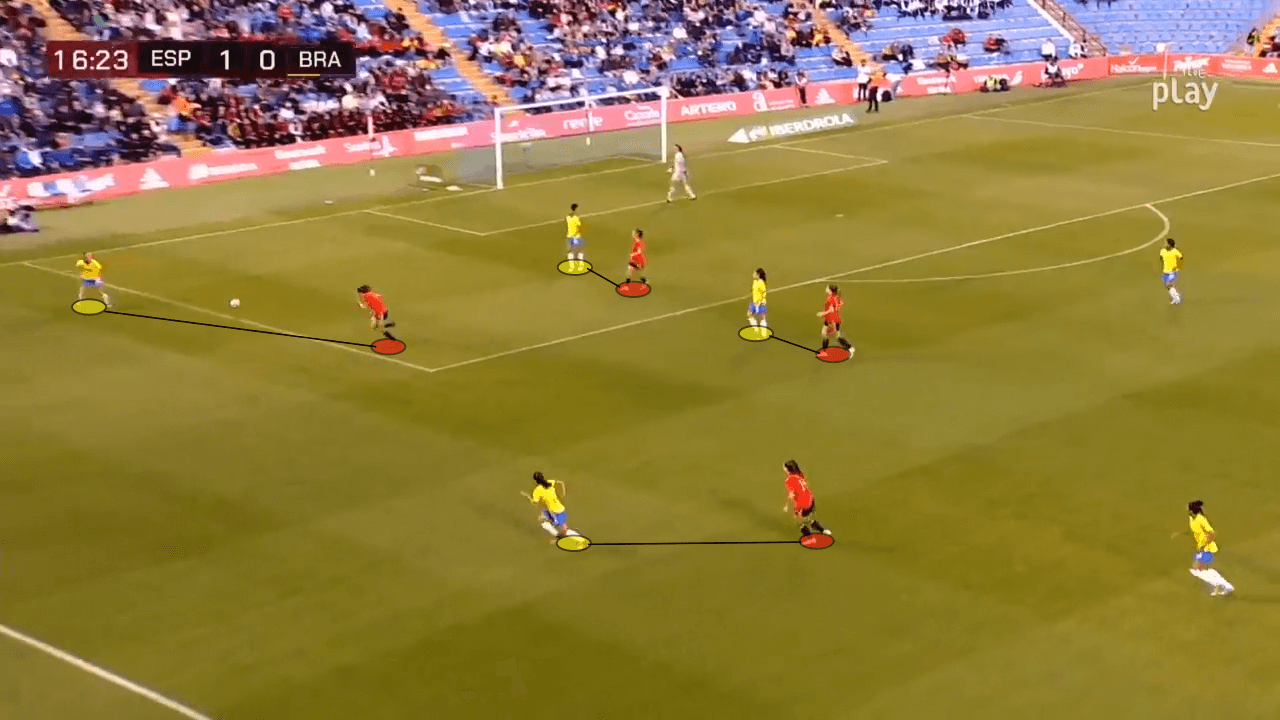
Moving as a unit is a significant characteristic of their press and allows them to be so overwhelming. This is especially seen in the image below. As England direct their build-up on the right side, Spain’s press shifts over. Bonmatí drops back into the midfield to close down their pivot. Spain’s left-back pushes up while the midfield comes across. They can create a 5v3 in this section of the pitch and significantly overwhelm England. As in possession, numerical superiority and overloads are a key part of Spain’s tactics.
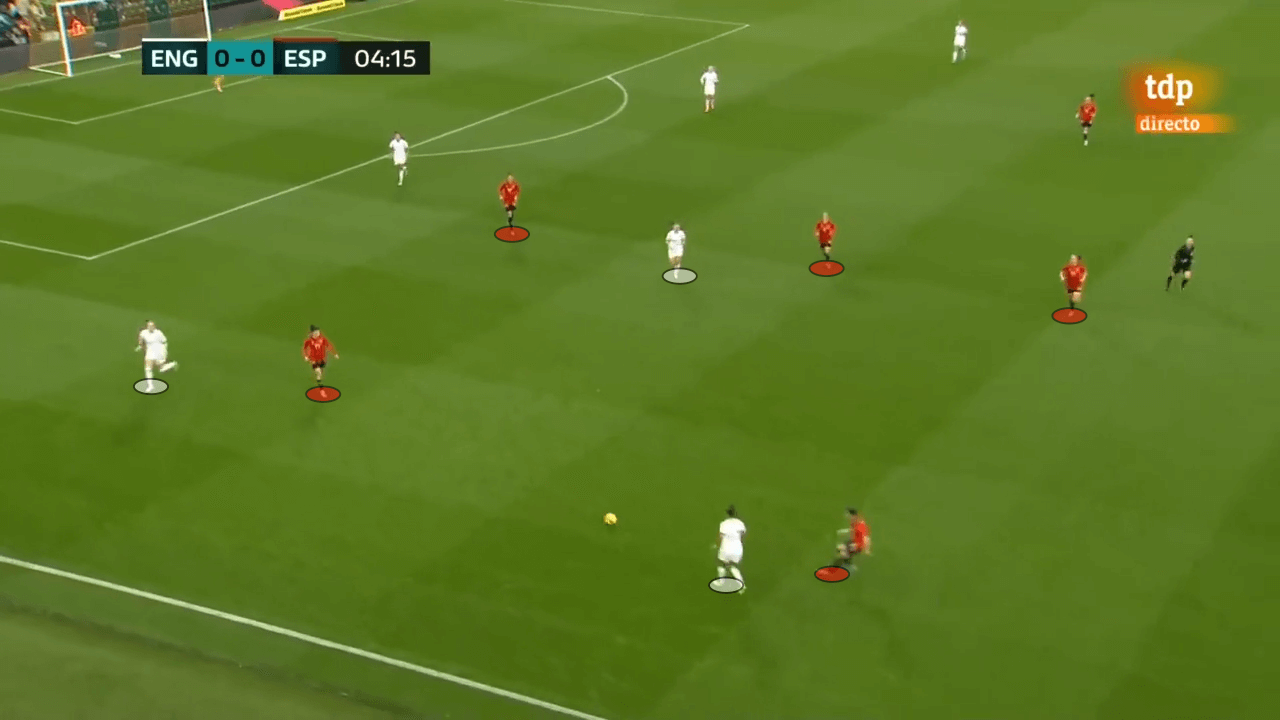
In lower blocks, this intensity is maintained. While remaining compact, they still constantly press and relentlessly challenge the opposition. They sit in a 4-4-2 with Bonmatí sitting alongside the centre-forward as she would in a high block.
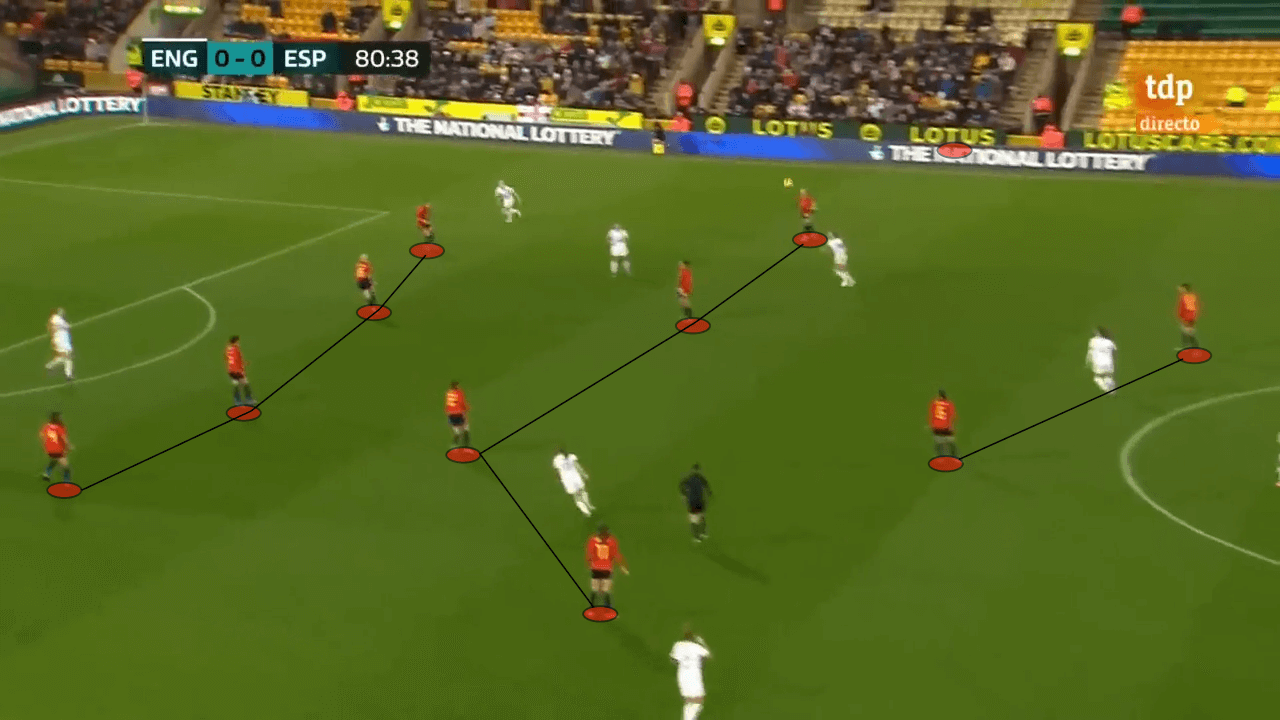
Transitions
La Furia Roja’s behaviour in transition aligns with their principles in and out of possession. The same obsession around having the ball is kept, and their collective behaviour in transition aims to achieve that. Firstly, they adopt an intense counter-press system which is consistently effective. This system is especially effective for one factor. In possession, they move as a unit and are constantly around the ball. Consequently, when the ball is lost, they already have so many players there to win it back. It is a possession system that is built to instantly and smoothly transition to the next phase.
In the example below, after the Brazilian player wins the ball, Spain already has a player there to stop the immediate counterattack. Meanwhile, two other players come pressing from the other direction. La Roja surrounds the ball carrier and overwhelms them into losing possession.
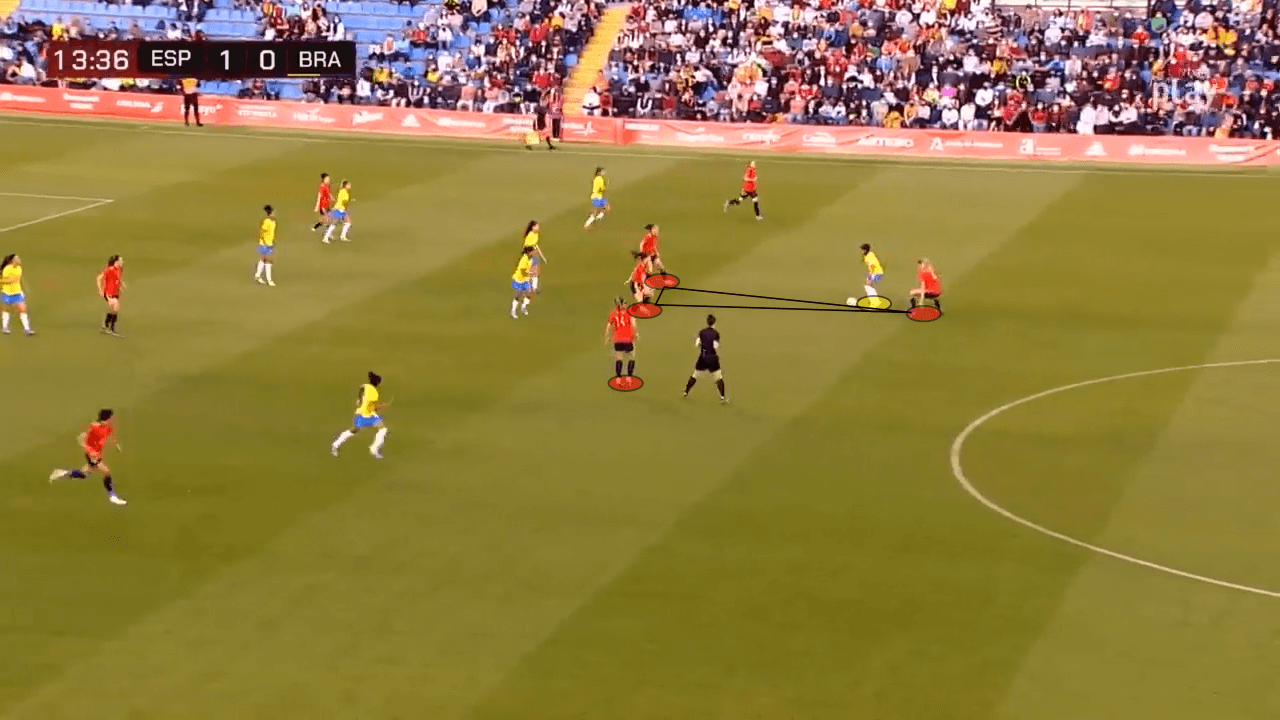
Against Scotland, the same behaviour can be illustrated. While one player stops the Scottish player from immediately driving forward, others come in to swarm her. In this case, three players pressure and create a diamond shape around her, leaving her with no way out.
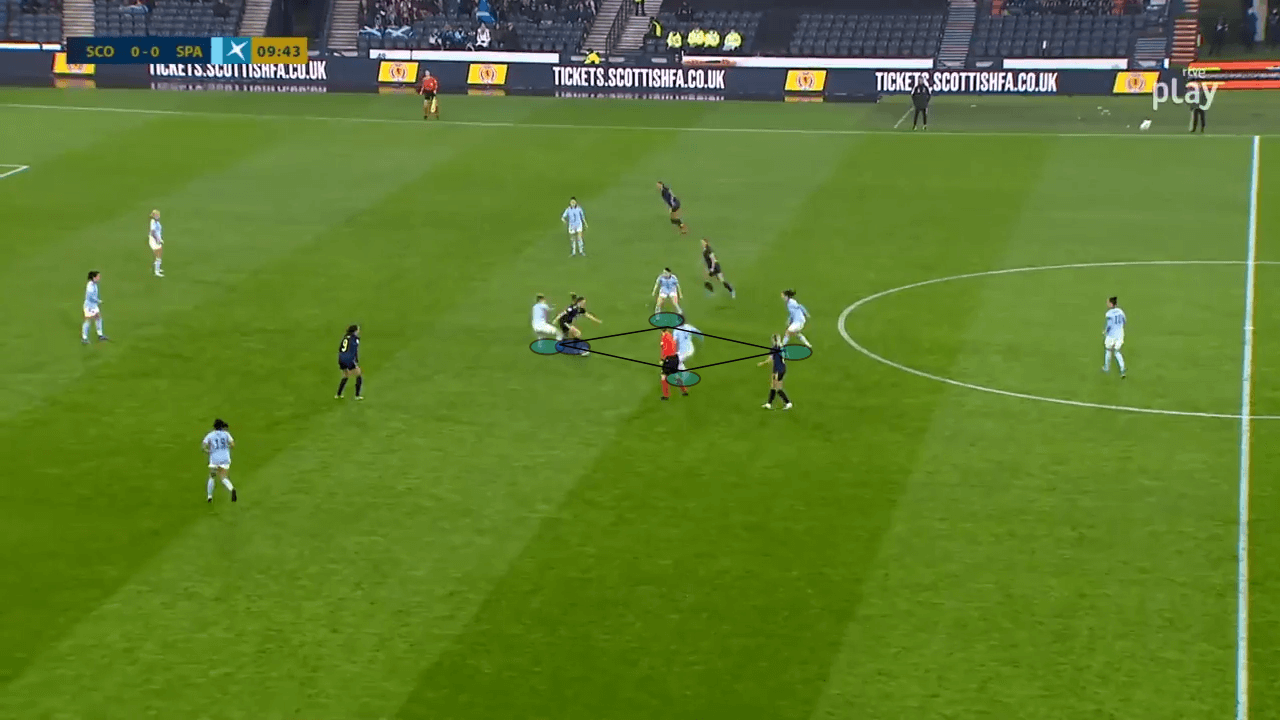
Transitioning to attack, Spain do not have an absolute strategy. Their behaviour is dependent on the situation at hand. When recovering the ball in their own third, they are hesitant to immediately throw players forward and will rather retain possession instead. In the middle third, the same can be said though there are times they push forward. When pressing high up the pitch, however, they will almost always counterattack upon recovering the ball. This is not only due to being in a very dangerous area but also often having numerical superiority in that area.
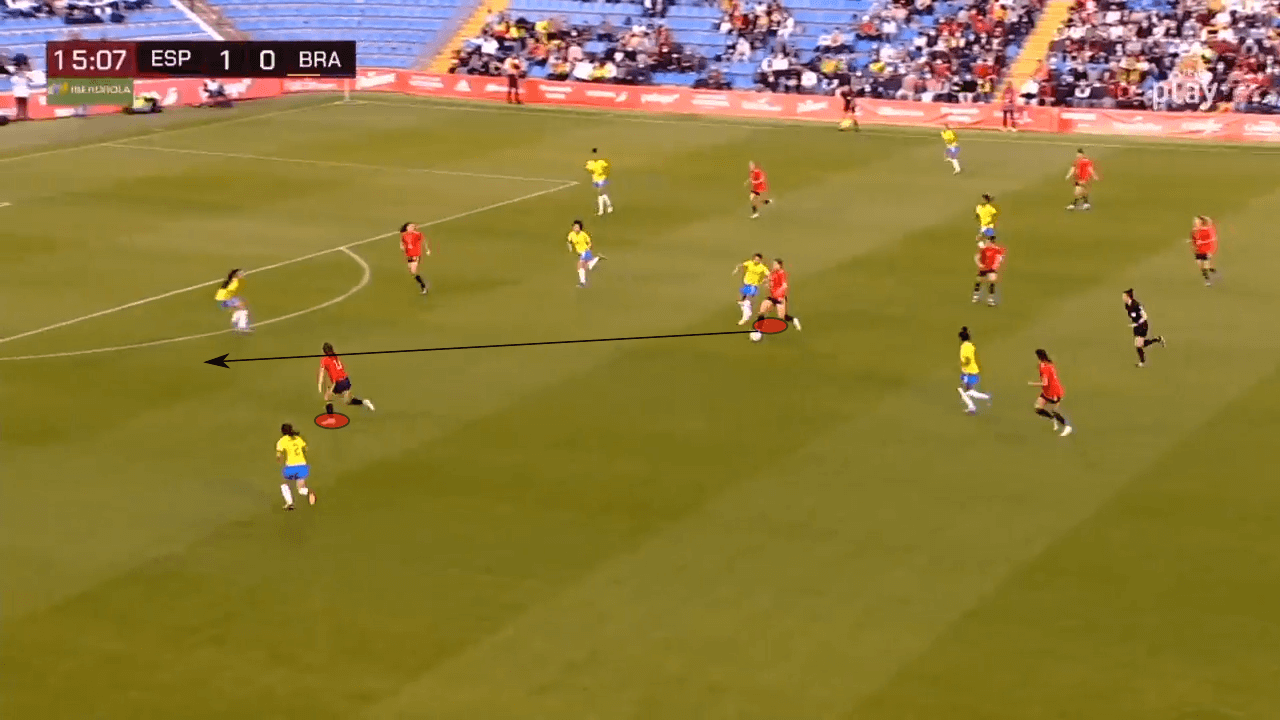
Vilda’s side has one idea which dictates their tactics throughout the four different phases: having the ball. In possession, they will value and dominate possession, attacking in a manner that does so while still being dangerous. Out of possession, they aim to recover the ball as soon as possible. In transition, the same idea is followed. Transitioning out of possession, they will immediately counter-press and attempt to recover the ball. Into possession, they will often simply retain possession though they will counterattack when higher up the pitch. In summary, the many principles and sub-principles revolve around the idea of having the ball.
Forwards
In the last calendar year, Spain has averaged 3.33 xG per 90 from 23.67 shots per 90. La Roja’s attacking output is uncontested, with some key players leading the line. Unfortunately, Spain’s all-time leading goalscorer, Jennifer Hermoso, has been ruled out of the competition due to injury. However, Barcelona’s Clàudia Pina is one of the most probable replacements. Despite being just 20 years old, she scored 0.7 goals per 90 in the 2021/22 season. Although she is naturally a wide player, she has occasionally featured up top for Barcelona and is an amazing goalscorer. Athenea del Castillo, Esther González, and Amaiur Sarriegi are other possible replacements. Hermoso was such an important player, that replacing her will be no easy task.
On the left, Mariona Caldentey has been exceptional for Barcelona this season with 0.87 goals per 90 and 73.71 passes per 90. Her attacking output and involvement in possession are incredible. On the right, Athletic Club’s Lucía García is the most probable option. García’s numbers are not quite as impressive as she does not play for a club as dominant as Barcelona. However, she has still maintained a fairly good scoring output with 0.27 goals per 90 from 0.36 xG per 90.
Midfielders
The midfield is perhaps the most predictable section, with Vilda most likely deploying Barcelona’s midfield trio. The deep-lying playmaker Patri Guijarro will be an unseen hero, orchestrating possession and dictating play. Ahead of her, Aitana Bonmatí will be joined by the best player in the world Alexia Putellas. Putellas’ contribution to this Spanish side cannot be understated. Not only does she have an incredible goalscoring record for a midfielder, but she is a creative force that makes Spain’s attack so dangerous. In the 2021/22 season, Putellas scored 0.88 goals per 90 and had 0.38 assists per 90 for club and country. The three’s varying characteristics make them a well-balanced world-class midfield, already used to playing together for Barcelona.
Defenders
Since the 2019 World Cup, Vilda’s defensive system has been outstanding. La Roja’s defence provides security and consistency that will prove essential in the knockout stages. Much of it is attributed to their ability to press high up the pitch and dominate possession. Nonetheless, their individual and collective work should not be undervalued.
The backline has been fairly consistent, with Ona Batlle on the right, María Pilar León and Irene Paredes centrally, and Leila Ouahabi on the left. Besides Batlle, the three others also played for Barcelona and are very familiar with each other. The fullbacks do an amazing job of providing support in the attack while the defence as a whole does an outstanding job of building up. Defensively, their consistency and organisation have been incredible, only conceding 0.36 goals per 90 in the last calendar year.
Best Performer
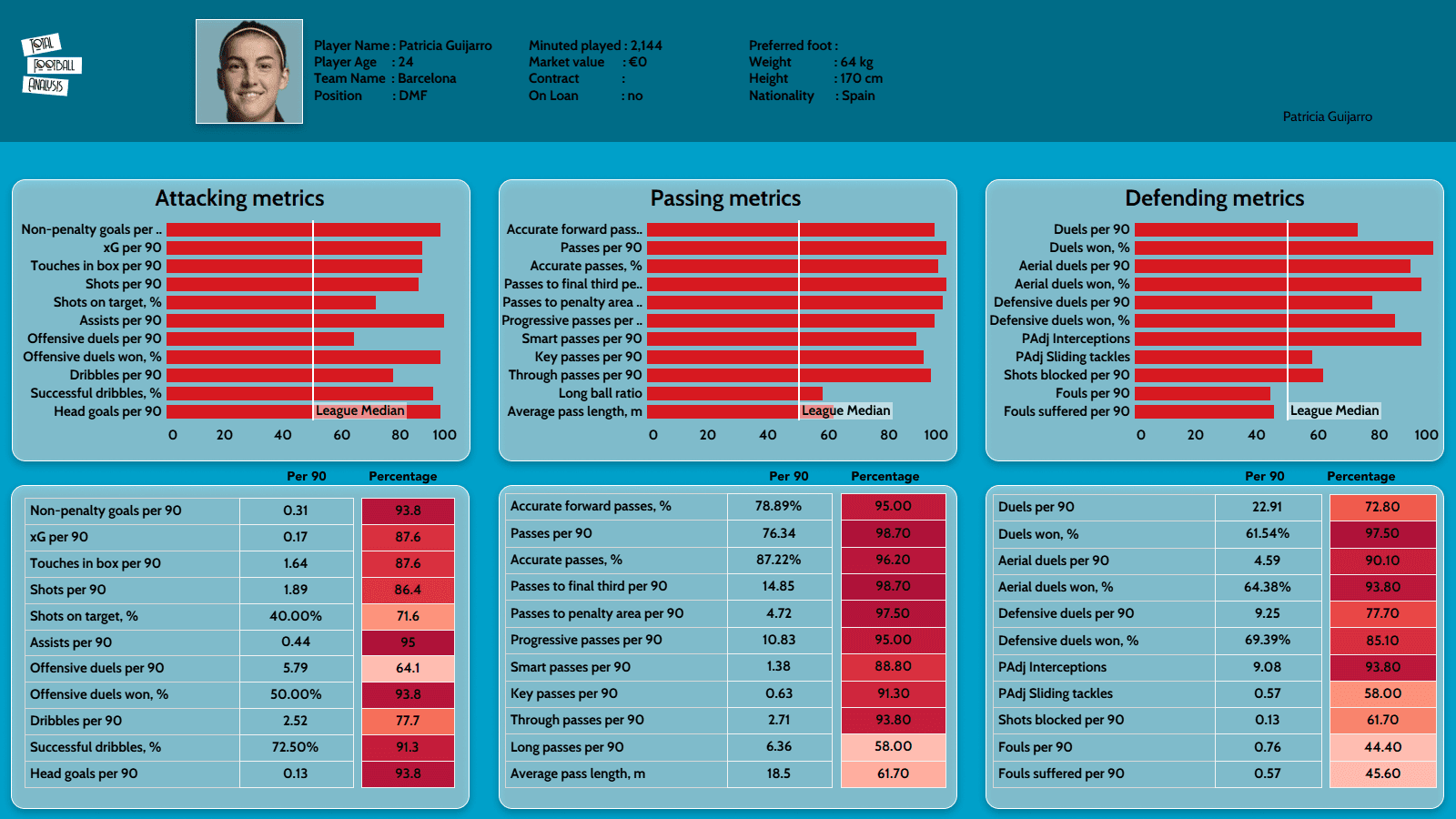
While Putellas is undoubtedly Spain’s, and the world’s, best player, Patri Guijarro will be an unseen hero for La Furia Roja. The midfielder acts as the single pivot in a talented midfield trio. Her involvement in possession — as indicated in the image breaking down her domestic performances for the last calendar year and comparing her statistics in each area with the league median — is crucial, often orchestrating the build-up and dictating the attack. She is the heart of the team in and out of possession. Defensively, she will command and oversee the press, covering for any spaces left. She is also key in maintaining organisation and leading the midfield defensively.
Her profile above is outstanding in every category, highlighting her importance in all phases of the game. She has well-above-average statistics, leading most metrics and all three sections. Similar to Busquets in the men’s team, she will be the glue that tactically holds the midfield and the team together.
Tournament Prediction
Despite only making it to the semi-finals once in 1997, Spain enter this year’s Euro as one of the title candidates. Barcelona’s recent success is the tip of the iceberg that makes La Roja so strong. Not only do they possess tremendous talent in every area, but they also have great depth. Jorge Vilda has been very successful in implementing a true Spanish identity to this side, playing beautiful and entertaining football.

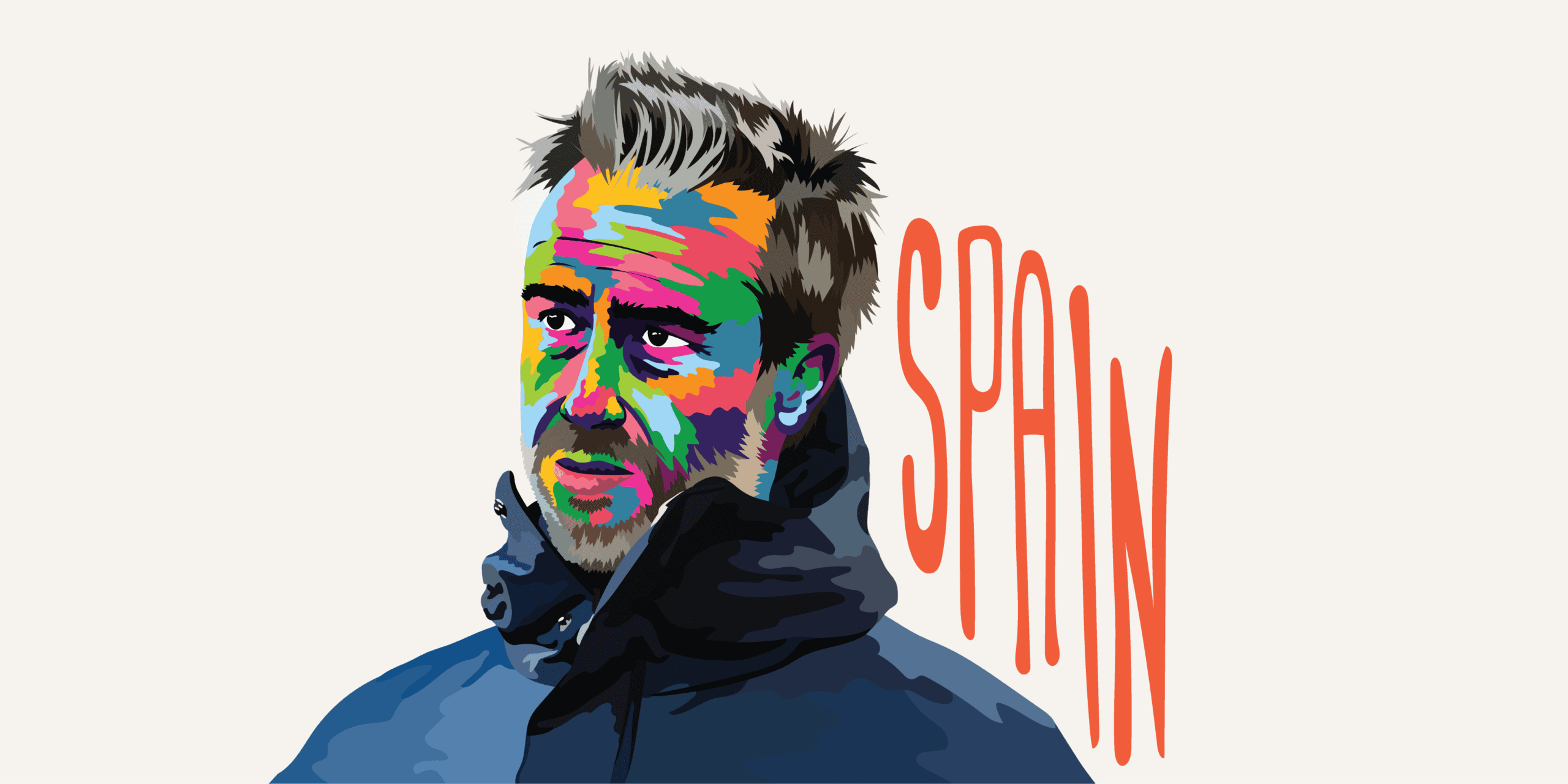



Comments